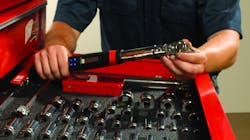Tool control has always been a critical aspect of the aviation industry. While a missing tool in an automotive bay can lead to inefficiencies, plus the cost for tool replacement, a tool that gets left behind on an aircraft or dropped on a ramp can lead to much more devastating consequences. Despite the high stakes, the onus has generally been placed upon individual companies to ensure accountability for their tools.
Some MROs require technicians to bring their own boxes to the hangar, creating an environment where it’s nearly impossible to implement any sort of comprehensive uniform tool control guidelines. There’s a better way to go about establishing a tool control program…and yes, you do need one. Here’s why:
Creating a tool control program means eliminating the hodge-podge of technician-owned boxes and deploying company-supplied tools for consistency in the hangar. There needs to be a uniform benchmark for tools, as well as a method to accurately track and monitor them. A lack of standardization and control over the number and type of tools can result in accidental oversight and unnecessary risks.
So, what constitutes a tool control program? The goal of a credible tool control program is to minimize the FOD threat to aircraft and equipment. To accomplish that effectively, any credible system should meet five criteria: organization, visibility, access control, asset management and automation. These factors, when added together, work to provide a detailed process of tool inspection and accountability, both before and after a job is completed, as well as a process that is repeatable.
Questions you should ask yourself in designing a tool control program include:
· What is the goal of a tool control program for your organization?
· How extensive will the program be?
· What materials will be monitored?
· Who can perform a general inspection of the area?
· What forms, if any, should be required?
· Will all the tools in the flight department be monitored?
Considering these questions will help you begin evaluating the scope of your tool control needs and get you started correctly on the path to success. It’s also going to reduce FOD concerns, improve accountability, as well as promote an atmosphere for crib attendants and technicians to be more productive.






